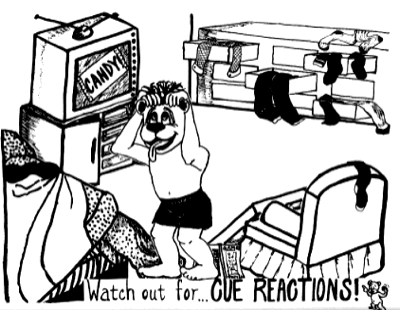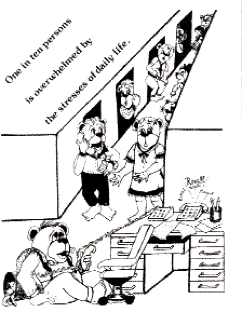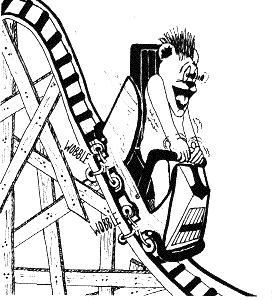Pick-Me-Up's
PICK-ME-UP'S
When you don't feel well, you normally try to do something to make yourself feel better. In turns out that all around you are substances which can temporarily make you feel better. Nature has provided a host of these Pick-Me-Up's that you can eat, drink, inhale or inject.
All these Pick-Me Up's work by chemically boosting one or more of your Happy Messenger levels, thus helping to temporarily restore balance to your OVERSTRESSED brain.
CAUTION: USING PICK-ME-UP'S TO BATTLE OVERSTRESS IS A BAD IDEA!!!
THEY DON'T WORK FOR LONG, AND THEY CAUSE PROBLEMS.....The following information is meant to help you understand why this is so......
Pick-Me-Up's are the wrong way to handle overstress!!!!
Now, read on to understand why.
A Pick-Me-Up can temporarily let you sleep better, help relieve an ache or pain, or give you energy. Here is a list of common Pick-Me-Up's that OVERSTRESSED people use. All of these work by virtue of causing an increase in Happy Messenger levels.
Sugar
The sugars: glucose (honey), lactose (milk sugar), fructose (fruit sugar), and sucrose (cane sugar) are called simple sugars. They are relatively tiny sugar molecules which are easily absorbed by the body. These sugars are absorbed so readily that placing honey under your tongue will cause an increase in blood sugar practically identical to injecting it intravenously. A sudden rise in blood sugar leads to an immediate boost in Happy Messenger levels. Simple sugars are, by far, the most popular and most widely used Pick-Me-Up.
Caffeine
Caffeine is a brain active drug that leaves your general blood circulation, enters your brain, and causes a boost in your brain Happy Messengers. We all are aware of caffeine's energizing capabilities, as caffeine is probably our second most widely used Pick-Me-Up. It is important to note that caffeine is found not only in coffee, but in chocolate, in sodas, and many teas.
Alcohol
Drinking alcohol is a powerful booster of brain Happy Messengers. It helps the Body Clock function, which helps people sleep. It helps people feel energized and aggressive. It diminishes pain sensation and increases pleasure. Thus, it should not be surprising that the alcoholic may take a drink to fall asleep, take an "eye opener" to get going in the morning, have a drink to feel more assertive when he goes in to see the boss, take a drink so he is "feeling no pain," or drink to make social gatherings "more fun." Alcohol is the third most widely used Pick Me-Up.
Interestingly, solvents of various kinds can act as a Pick-Me-Up, having an effect similar to alcohol. The solvent vapors, when inhaled, enter the blood and act directly on the brain. There, they cause a boost in brain messenger levels and act as a Pick-Me-Up. Many solvents will do this: glues, cleaning fluids, nail polish remover, oil based paint. We mention these because most people who work around these solvents will not even realize that these solvents are directly affecting their brain, and acting as Pick-Me-Up's.
Tobacco, Marijuana, Cocaine, Amphetamines, Heroin
Tobacco, marijuana, cocaine, amphetamines, and heroin are chemicals that directly boost brain Happy Messenger function. They are widely used and extremely potent.
Your Own Adrenalin
As we mentioned earlier, when the body prepares to either fight, or run, a hormone called Adrenalin is released from the adrenal glands. Adrenalin is a cousin of Noradrenalin. Adrenalin release instantly boosts brain Noradrenalin function.
Remember how you almost fell asleep while driving? You caught yourself just before you crossed over the center divider to hit an oncoming car. Boy, did your heart beat, and you were certainly awake after that!
Many people use their own Adrenalin release as the Pick-Me-Up they need to feel healthy. A common instance of this is a "workaholic". The workaholic is terribly OVERSTRESSED. Instead of trying to reduce his stress load, however, his solution is to work sixteen to twenty hours a day, thus keeping himself "high" on his body's own Adrenalin release.
Another example is found among the persons who engage in high risk, "high excitement" sports or gambling. Here will be found many who are suffering from OVERSTRESS, and who use the sport or the gambling as their major Pick-Me-Up. Instead of reducing their stress level, these persons use their own Adrenalin to boost their brain Happy Messenger levels back toward normal.
HOW MANY OF THESE PICK-ME-UP'S DO YOU USE EVERYDAY?
Sugar
• Milk(LACTOSE)
• Fruit(FRUCTOSE)
• Honey(GLUCOSE)
• Cane or Beet Sugar(SUCROSE)
• Corn Sweeteners(FRUCTOSE) (Eating whole fruit is OK. Fruit is beneficial for fiberand vitamins. But watch out for fruit juices and high fructose corn sweeteners, both of which are POTENT Pick-Me-Up's.)
Caffeine
• Coffee
• Black Tea
• Chocolate
• Colas
Alcohol
• Beer
• Wine
• Whiskey
• Liquor
Other Solvents
• Nail Polish Remover
• Paint Thinner
• Oil Based Paints
• Glues
• Gasoline Fumes
Your Own Adrenalin
• Workaholic
• Shopping Sprees
• Gambling Sprees
• Thrill Seeking Hobbies
Drugs
• Marijuana
• Cocaine
• Amphetamine
• Heroin
Tobacco
• Cigarettes
• Chewing Tobacco
• Snuff
Now note how often they are all combined in the same product, i.e., a chocolate bar (sugar and caffeine); a chocolate rum cake (sugar, caffeine and alcohol); Kahlua with coffee and cream (sugar, caffeine, and alcohol). And often these are combined with a cigarette.
USING PICK-ME-UP'S IN STYLE
Persons who are in OVERSTRESS situations commonly use Pick-Me Up's in two styles, "Maintenance" and "Binging".
Maintenance User
The Maintenance User tries to maintain a constant supply of Pick Me-Up's at all times. Tom, for example, may have coffee in the morning to "wake up". Then he will have colas, coffee with milk, and assorted sweets during the day. An alcoholic beverage after dinner helps relaxation. And a drink at bed time helps him fall asleep. Maybe the next day it will be three glasses of milk and eight chocolate chip cookies in the morning.
The specific Pick-Me-Up used may vary each day, but John is always munching on some Pick-Me-Up. John is walking a tight rope, balancing his host of stressors on the one hand against this variety of"medicines" on the other. Pick-Me-Up's give him energy, Pick-Me-Up's help him relax, Pick-Me-Up's help him sleep.
Binging
Mary, on the other hand, may not use Pick-Me-Up's for weeks. But then, one day, she eats a whole box of chocolates, or three boxes of donuts, or two six packs of beer, or all of these things combined. Then, after this orgy of sugar, caffeine and/or alcohol, she is fine again for a long time.
The physiology behind John's behavior is clear. His stressors cause him to feel very uncomfortable. His Pick-Me-Up's help him to feel normal. So he uses Pick-Me-Up's as "medicines, "medicines provided by nature, medicines that help him feel well.
But what about Mary? What could account for such a strange behavior on Mary's part? Why does she do without for long periods of time and then binge?
The answer lies in the depth of the brain, in a collection of brain cells knows as..."the Pleasure Center".
In the 1950's scientists began studying the effects of passing a minute electric current through certain parts of an animal's brain. In 1954 it was discovered that direct stimulation of certain brain areas could be extremely rewarding to an animal. Electrodes were implanted in the brain of a rat, and connected to a self-stimulation lever. (This is a lever inside the cage which the animal can press, sending a little electric current into its own brain.) To the amazement of the scientific community, self-stimulation of certain areas of the brain seemed so rewarding that an animal would endure severe punishment just to reach the lever and press it.
In 1965, one special area of the brain was discovered. Stimulation here was so rewarding that hungry rats, given a choice between eating, or pressing the lever, would choose to press the lever until they actually starved to death. By the late 1960's, the evidence was piling up. There appeared to be a group of areas in the brain that could give an intense reward to an animal whenever those areas were stimulated. These areas may be regarded collectively as... the Pleasure Center.
That such a Pleasure Center does exist in humans has been verified in neurosurgical operations. You see, the brain itself is devoid of pain fibers. So neurosurgery can be performed with the patient awake and alert. During certain surgeries, required by conditions such as tumors or severe epilepsy, the Pleasure Center of human beings has actually been stimulated. When the patient is basically comfortable and relaxed, the stimulation is reported as mildly pleasureful.
But when the patient is depressed (when his Happy Messengers run low) the stimulation is reported as "wildly pleasureful". Indeed, such patients, given a button to press may stimulate themselves more than 400 times an hour.
This discovery is of great significance in the understanding of how Pick-Me-Up's work. It turns out that Pick-Me-Up's are capable of directly stimulating this very same Pleasure Center. By design, the Pleasure Center relies on brain Happy Messengers for its stimulation. Hence, using Pick-Me-Up's boosts Happy Messenger levels, and directly stimulates the Pleasure Center.
If a person already has an adequate supply of Happy Messengers, the additional stimulation is nice, but not really compelling. But if OVERSTRESS has caused a large deficiency in Happy Messenger functioning (if one's Pleasure Center is, in effect, "starved" for Happy Messages) then the effect of the Pick-Me-Up is enormous.
Just as the lever and electrode had led to an uncontrollable self-stimulation in the animal; just as the button and electrode had led to wild self-stimulation in the neurosurgical patient; so a Pick-me-Up may lead to fits of uncontrollable -- totally uncontrollable -- self-stimulation in the Pick-Me-Up user.
In the extreme case, such episodes of self-stimulation, such binges, may continue until the person is forced to vomit up his Pick-Me-Up's, or in the case of alcohol, until the person drinks himself to unconsciousness.
This explains why one person may take a Pick-Me-Up, an alcoholic beverage, for example, and find it mildly pleasureful, while someone with OVERSTRESS may take one drink and develop a bout of absolutely uncontrollable binging.
Cue Reactions
An important feature of Pick-Me-Up use is the so-called, "Cue Reaction". If you talk to binge chocolate eaters, or binge drinkers, or binge cookie eaters, they will often tell you that they really had no desire to have anything at all. They were just passing by the kitchen and noticed a bag of cookies that their roommate had bought for the picnic tomorrow. The next thing they knew, half the cookies were gone.
The smell of cookies baking, going over to mother's house, or even seeing a cookie advertisement in a magazine, can trigger cookie eating. In this case the trigger for eating was the mere sight of the cookies.
In essence, a Cue Reaction is a type of conditioned reaction. Every time you are in a situation in which you take a Pick-Me-Up, be it a cookie or an alcoholic beverage, you forge a link in your brain between the situation and the Pick-Me-Up. Then, when you are in a similar situation, your body will automatically reach for the Pick-Me-Up.
The beer industry has spent billions of dollars associating beer and professionalsports. Can you imagine sports on television without beer advertisements?
When football comes on the air, the beer commercials cause Cue Reactions all over the country. Viewers head towards the refrigerator for a can of beer. These reactions are automatic. Usually the person is unaware of any association between the Cue and the Reaction. You are watching television,talking and joking, and suddenly there is a beer in your hand.
You see, the actual decision to drink the beer has been made at a deep and primitive area of the brain. Thinking occurs in our outer brain layers known as the CORTEX. But the inner SUB-CORTICAL layer is responsible for coordinating AUTOMATIC functions of the body. When you walk, your sub-cortical brain swings your arms to balance you, it adjusts the blood flow to your muscles, it regulates your body's temperature, and breathing. All of this is automatic. You never have to think about it.
Pavlov demonstrated how easily one may condition the sub-cortical brain. He trained dogs to salivate at the sound of a bell. The sound of a bell was not food, but he trained the dogs to salivate at the sound. Likewise, the beer companies have trained much of the public to grab a beer when they hear the sound of football. Football has nothing to do with beer, but people have been trained to associate the two. And the association occurs at a deep level, distinct from our consciousness. Turn on the TV, out comes the beer. No thinking involved, it's all automatic. If it were not effective, the beer companies would not spend billions each year on such viewer training.
The Maintenance Pick-Me-Up user will develop a set of very strong Cue Reactions. For instance, after breakfast must be coffee. The first work break, more coffee. Lunch includes a soft drink. Arrive home to take a glass of Chablis. Wine with dinner and another glass before bed.
Because the conditioned use of Pick-Me-Up's is ingrained at a sub-cortical level, it becomes just as automatic as breathing in or out, or swinging your arms while walking. The Maintenance Pick-Me-Up user is no more aware of his use of Pick-Me-Up's than you are of your breathing right now. In fact, Pick-Me-Up's are so much a part ofour life, and they are so automatic, that the Maintenance Pick-Me-Up user is totally unaware that consumption of large amounts of simple sugar, caffeine, and alcohol are not "normal" or healthy for the body.
The Binge Pick-Me-Up user, on the other hand, may not usePick-Me Up's at all for long periods. But when OVERSTRESS conditions cause severe messenger imbalance in the brain, the stage is set for the binge. There, on the table, is a bag ofcookies. Or here are the guys to watch the big football game. Boom, you have a binge. It is quick, and it is automatic.
DRAW BACKS OF USING PICK ME UP'S
The symptoms of Happy Messenger failure: sleeping problems, aches and pains, lack of energy, lack of enjoyment of life, crying, depression, and panic attacks are brought on by conditions of OVERSTRESS. ---
TEN PERCENT OF OUR POPULATION IS FUNCTIONING IN OVERSTRESS RIGHT NOW --
Many persons in our society feel "out of balance" quite regularly. The common Pick-Me-Up's simple sugars, caffeine, alcohol, and tobacco are available all around us. In the United States at least thirty million people use them regularly to try and get themselves to feel "normal" again; to sleep well, to have enough energy, enjoylife, stop the anxiety or depression. Unfortunately, Pick-Me-Up's do not work very well.
The major drawback of the Pick-Me-Up's is the fact that: YOU CAN NEVER ACCURATELY REBALANCE YOUR BRAIN MESSENGERS USING PICK-ME UP'S.
That is something only your own body can do. Itis just too delicate a chemical adjustment. Try as you will, you will never be able to make yourself feel right using Pick-Me-Up's.
DESPITE THE USE OF PICK-ME-UP'S, A PERSON WHO IS SUFFERING FROM OVERSTRESS WILL CONTINUE TO FEEL "UNBALANCED".
By using Pick-Me-Up's, the person merely puts himself into a shaky equilibrium where he tries to balance a host of stressors, on the one hand, against a variety of Pick-Me-Up's on the other. Since it is impossible for a person to accurately rebalance his brain chemistry this way, he will sometimes feel "OK," but much of the time will have the mood swings, poor sleep, depression or anxiety of Happy Messenger failure. His will be a constant up-and-down ROLLER COASTER of feeling well and feeling ill.


